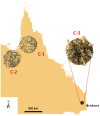Entropy of the Land Parcel Mosaic as a Measure of the Degree of Urbanization
- PMID: 33925218
- PMCID: PMC8145328
- DOI: 10.3390/e23050543
Entropy of the Land Parcel Mosaic as a Measure of the Degree of Urbanization
Abstract
Quantifying the urbanization level is an essential yet challenging task in urban studies because of the high complexity of this phenomenon. The urbanization degree has been estimated using a variety of social, economic, and spatial measures. Among the spatial characteristics, the Shannon entropy of the landscape pattern has recently been intensively explored as one of the most effective urbanization indexes. Here, we introduce a new measure of the spatial entropy of land that characterizes its parcel mosaic, the structure resulting from the division of land into cadastral parcels. We calculate the entropies of the parcel areas' distribution function in different portions of the urban systems. We have established that the Shannon and Renyi entropies R0 and R1/2 are most effective at differentiating the degree of a spatial organization of the land. Our studies are based on 30 urban systems located in the USA, Australia, and Poland, and three desert areas from Australia. In all the cities, the entropies behave the same as functions of the distance from the center. They attain the lowest values in the city core and reach substantially higher values in suburban areas. Thus, the parcel mosaic entropies provide a spatial characterization of land to measure its urbanization level effectively.
Keywords: Renyi entropy; Shannon entropy; city growth; land division pattern; land fragmentation; land parcel; spatial analysis; urbanization.
Conflict of interest statement
The authors declare no conflict of interest.
Figures











References
-
- Batty M. Spatial Entropy. Geogr. Anal. 1974;6:1–31. doi: 10.1111/j.1538-4632.1974.tb01014.x. - DOI
-
- Punia M., Singh L. Entropy Approach for Assessment of Urban Growth: A Case Study of Jaipur, India. J. Indian Soc. Remote Sens. 2012;40:231–244. doi: 10.1007/s12524-011-0141-z. - DOI
-
- Cabral P., Augusto G., Tewolde M., Araya Y. Entropy in Urban Systems. Entropy. 2013;15:5223–5236. doi: 10.3390/e15125223. - DOI
LinkOut - more resources
Full Text Sources
Other Literature Sources

